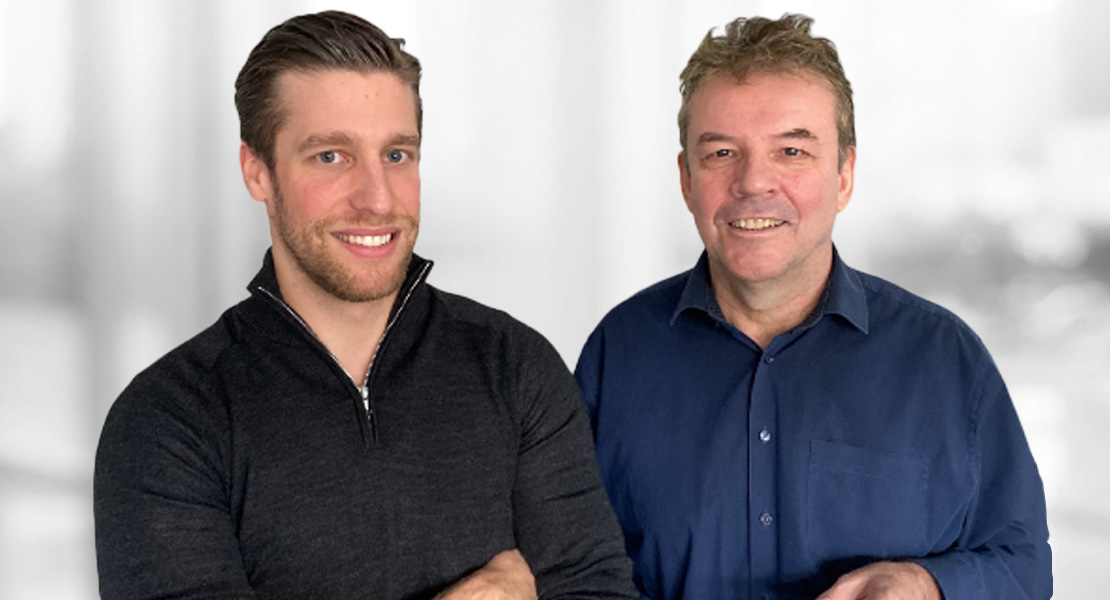Cloud-based route optimization using time-of-day speed profiles and a sophisticated algorithm — the future of transportation belongs to smart route planners. Certainly, with their help the journey from A to B can be completed faster and more efficiently. That is not all, however; better routes make a respectable contribution to reducing CO2 emissions. Greenplan, a young tech company that has emerged from Deutsche Post DHL Group, is committed to realizing both of these goals. An interview with Greenplan managing directors Florian Merget and Clemens Beckmann about sustainable transport on optimized routes.
Florian, Clemens, how exactly should we picture Greenplan’s solution in our minds?
Beckmann: We have developed a solution that calculates efficient and sustainable route plans. Numerous benchmarks demonstrate that our route plans are more than 10 percent more efficient than those created using traditional systems.
This superiority results from two factors. First, our algorithm takes into account time-of-day traffic flow speeds for each route segment when planning routes. It allows us to make very precise predictions about our arrival times and to comply very closely with time windows. Second, Greenplan can plan tours fully dynamically, i.e., without any predefined area boundaries. Moreover, we are able to adapt our solution to the specific circumstances of our customers. The use of our solution requires a critical mass, however — it is usually worthwhile for a fleet of more than 100 vehicles or for a volume of 200 or more tours per week.
What customers, what target groups do you address with your solution?
Merget: Our customers come from various industries, and the use cases among them vary. In the road freight business, we are looking at the segments “LTL” (Less Than Truck Load) and “PTL” (Part Truck Load). There is greater potential for optimization in these segments than is the case for “FTL” (Full Truck Load). Furthermore, we have many customers in the "last mile" sector who are driven by the e-commerce boom. Some of our customers operate in the express sector because our solution also incorporates very precise time windows for deliveries into its calculations. In addition, we are active in the field service pharmaceutical logistics. Still, our clientele also includes traditional postal service companies.
This sounds like very different requirements for individual customers — factors that are also not always easy to model.
Beckmann: Yes. And these factors are exactly what prompted us to develop our business rule engine. While the core of our algorithm always strives for maximum efficiency, the business rule engine ensures that other criteria are met. Notional costs sanction undesirable behavior, even if the solution based solely on the strict specifications would be possible. A simple example of this is delivery times. Suppose a shipment is supposed to be delivered by 6 p.m. of a specific day for quality reasons, but the actual deadline is 8 p.m. Our business rule engine allows us to apply notional costs for every minute after 6 p.m. that the delivery takes place. An incentive for the system to satisfy the requested condition — if possible — is generated.
This requires flexibility and plenty of modeling work with long implementation times. After that, however, the solution fits like a tailored suit.
Can you give us an example of a particularly challenging rule?
Beckmann: For us, trailer handling was a very complex issue. Certain customers in freight transport handle consignments comprising multiple elements rather than single items. Once a trailer has been loaded and hitched to a truck, it is of course no longer possible to load and unload the front truck. Such factors must be taken into account during planning. Another case is refrigerated transport as sometimes only one section of the truck is refrigerated, requiring planning with two types of capacity in one vehicle. The only thing we can’t combine with the software is an optimal packing instruction for the specific route. Packing instruction means mastery of the so-called “Tetris game” of geometrically optimal arrangement of all packages in the cargo area.
Another highly demanding task: unscheduled pick-up events. These are situations when goods are scheduled for collection, but time and place have not yet been precisely set. The procedure must always calculate whether there is still enough space in the truck and whether any later time windows might possibly be “shattered” by a detour.
The transport sector contributes a major share of global CO2 emissions. To what extent does the increase in efficiency achieved by your solution have an impact in terms of environmental sustainability?
Merget: First of all, this thought is in our name — Greenplan. When we optimize or improve route planning, we usually reduce the mileage driven by as much as 20 percent. This is both an important selling point and our contribution to climate-friendly solutions.
Beckmann: Another important lever for greater sustainability is the electrification of fleets; we can currently use the range of electric vehicles to plan their effective use on our road map. Then there are city and municipal regulations requiring CO2-neutral means of transport in certain zones. We foresee the implementation of increasingly strict rules in urban areas. Since these rules can be modeled in our solution, we can meet these requirements.
Greenplan is a young technology company that has been spun off from Deutsche Post DHL Group. What were the reasons behind the successful spin-off of your company at this specific time?
Beckmann: There were two primary reasons for our decision. For one, everything related to software and its development is foreign to Deutsche Post DHL. In most cases, solutions are also procured externally because they are highly mathematical or have a highly complex structure. The core business of our parent company is the organization and efficient performance of transports, not software. A very few companies have developed this area completely for themselves — one well-known example is UPS and its ORION solution. We want Greenplan to serve other postal services as well. Large freight companies and other postal services would have reservations if Deutsche Post DHL were still the primary Greenplan shareholder. Thanks to the management buyout, we can now continue to expand Greenplan’s growth and have the necessary industry knowledge and skills within our team to make the most of global business opportunities.
What is your vision for the future? Where do you want to see Greenplan in five years?
Merget: Our five-year objective is to become one of the leading players on the market for route planning and route optimization, and we expect to be represented in many other regions worldwide. We will maintain our clear focus on the product and become even more familiar with requirements posed by drivers and addresses, for example. Furthermore, we want to align even more closely with future customer requirements so that we can offer a more holistic approach in our solutions.
Beckmann: In the coming years, we will also be looking at the extent to which we can apply our Greenplan methods to flight scheduling or shipping.
Clemens, Florian, thank you very much for these interesting insights into Greenplan’s work!







